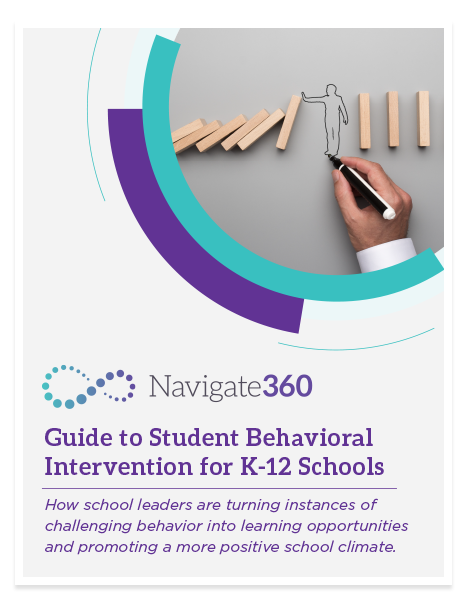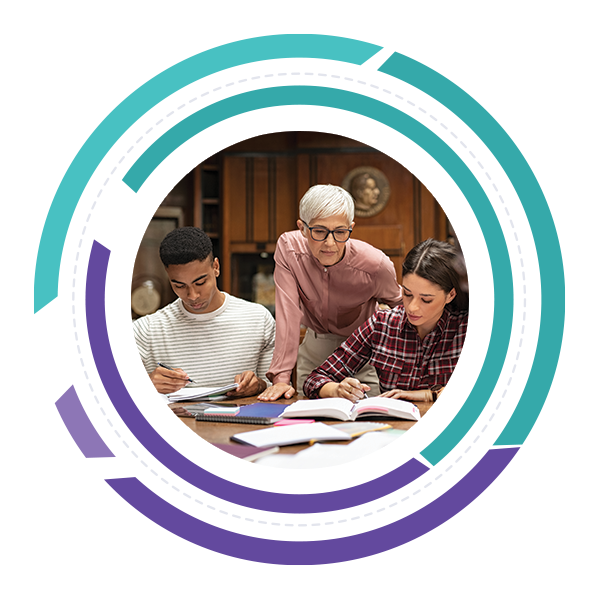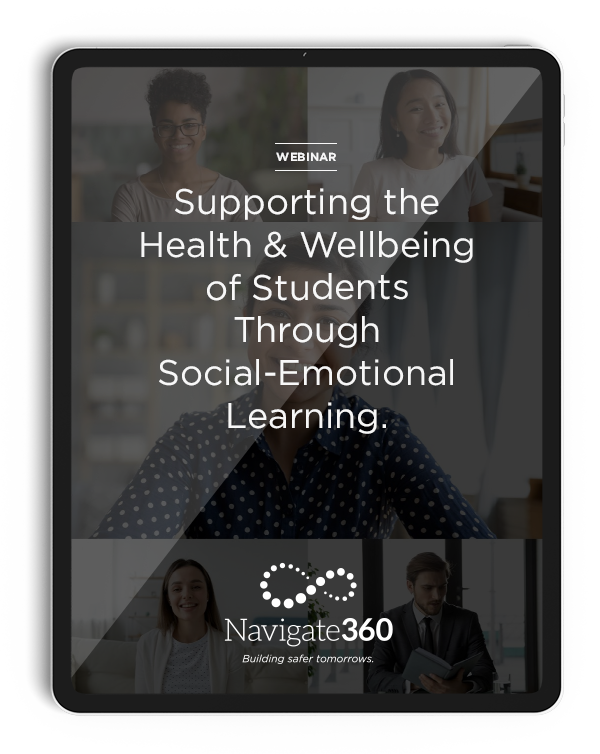Guide to Student Behavioral Intervention for K-12 Schools
How school leaders are turning instances of challenging behavior into learning opportunities and promoting a more positive school climate.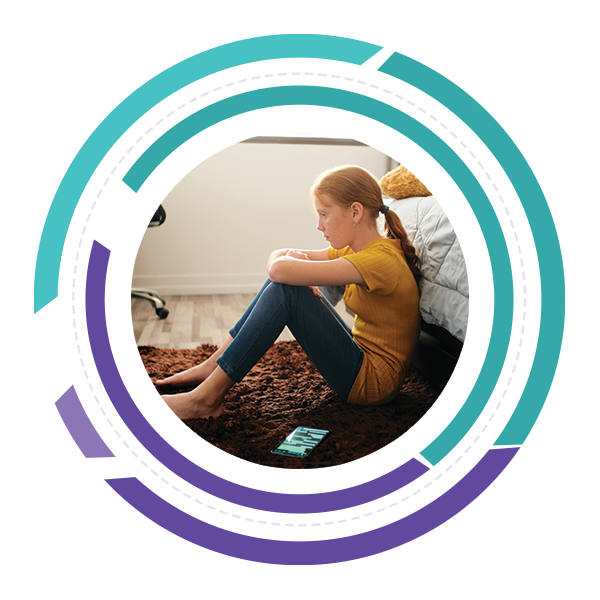
Addressing challenging behaviors in students is a difficult but necessary part of educators’ and administrators’ roles. A school’s response to students behaving in difficult or confrontational ways is critical to the educational success of the entire student body and the school climate as a whole—including the student acting out. Deciding on an effective behavioral intervention strategy is a must in helping students learn from their actions and thrive educationally, socially, and emotionally.
Understanding and Responding to Common Behavior Issues in K-12 Students
![]() Of course, finding and implementing the right behavioral intervention strategy isn’t without its difficulties. In the wake of the COVID-19 pandemic and its associated social, emotional, and mental health challenges, school officials must be able to adapt their response to unforeseen challenges. Issues that have always impacted school communities such as substance abuse, poverty, abuse, and special needs also continue to impact students’ lives and are often expressed through their behavior.
Of course, finding and implementing the right behavioral intervention strategy isn’t without its difficulties. In the wake of the COVID-19 pandemic and its associated social, emotional, and mental health challenges, school officials must be able to adapt their response to unforeseen challenges. Issues that have always impacted school communities such as substance abuse, poverty, abuse, and special needs also continue to impact students’ lives and are often expressed through their behavior.
The traditional disciplinary responses from schools include detention, suspension, and expulsion. While utilized for decades in districts throughout the country, these responses share a common theme: The primary consequence associated with these measures is learning loss. Offending students have fewer opportunities to learn from their challenging behaviors or adopt new behaviors, and face a punitive response instead. Additionally, the stigma attached with suspension and detention often follows a student and affects how school staff respond to them across their school career. Recent research conducted by Harvard Graduate School of Education indicates that students who attend a school with a high suspension rate experience many negative impacts later in life. That means that schools with high suspension rates are negatively affecting their students, years beyond graduation.
Administrators Often Lack Resources for Establishing Updated Behavioral Intervention Programs
A common problem facing school administrators tasked with implementing an effective behavioral intervention program is a lack of resources. The personnel who have the expertise to create an effective behavioral intervention program are typically special educators who likely have other full-time responsibilities to tackle. And while many schools have an exceptional student education (ESE) program, students who are not within the program won’t be working with the special educators best equipped to help them. This usually results in teachers and administrators responding to challenging behavior, often without any formal training in behavioral intervention. For many students, that leads to a disciplinary cycle of detention, suspension, and expulsion that they may never get out of and results in learning loss.
Addressing Challenging Behaviors Through Social-Emotional Learning Programs
Thankfully for administrators, there are new tools for addressing challenging behaviors in students. Social-emotional learning (SEL) programs help fill a gap that is often present in traditional education by teaching students the knowledge, skills, and attitudes that can help them manage their emotions, navigate social situations, establish and maintain meaningful and supportive relationships with others, and become caring individuals.
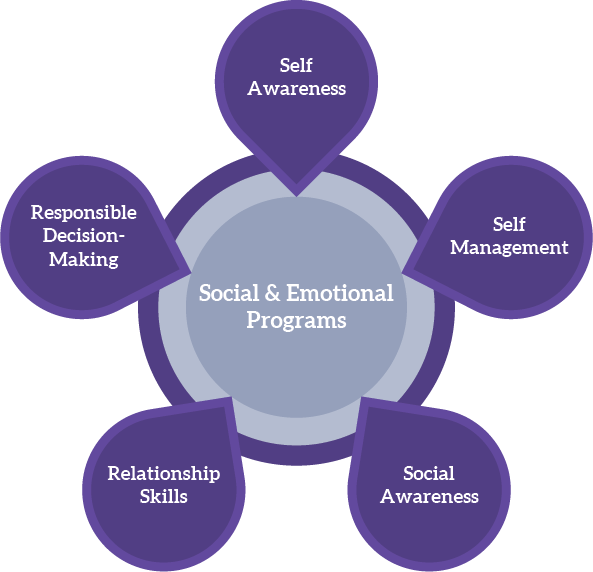 The core concepts behind SEL programs—self-awareness, self-management, social awareness, relationship skills, and responsible decision-making—provide a framework for students to navigate their own emotions and those of their peers. In fact, recent studies have shown that SEL skills help protect students from becoming targets of bullying and lower the risk of someone bullying others.
The core concepts behind SEL programs—self-awareness, self-management, social awareness, relationship skills, and responsible decision-making—provide a framework for students to navigate their own emotions and those of their peers. In fact, recent studies have shown that SEL skills help protect students from becoming targets of bullying and lower the risk of someone bullying others.Without these invaluable life skills, students have a more difficult time dealing with common stressors they face, like bullying and anxiety. With repeated exposure to these stressors, students can fall behind academically and socially, often resulting in challenging behaviors that disrupt the learning environment.
An effective SEL program has specific training and modules for educators and faculty, too. After all, a teacher’s response to challenging behavior is likely going to be different from an administrator’s, so both groups need specific tools to accomplish their goal of helping students.
What are Restorative Practices?
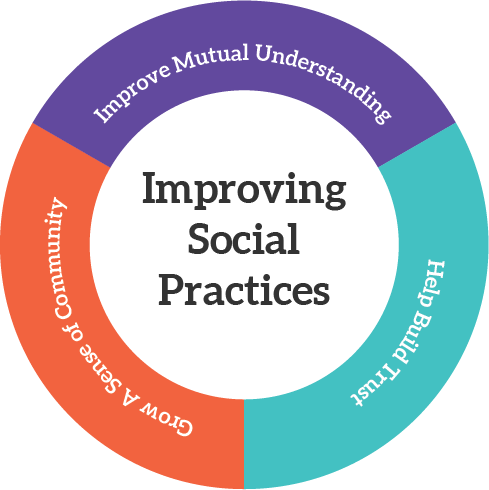 When researching updated behavioral intervention programs, a term that is often repeated in modern literature is “restorative practices.” In many ways, restorative practices are the opposite of a traditional punitive, or punishment-based, response to challenging behaviors. The International Institute for Restorative Practices (IIRP) defines restorative practices as a “social science that studies how to build social capital and achieve social discipline through participatory learning and decision making.” In layman’s terms, that means social practices aim to improve mutual understanding, trust, and a sense of community. This can help reduce crime and violence, improve behavior, strengthen leadership, restore relationships, and repair harm throughout a community.
When researching updated behavioral intervention programs, a term that is often repeated in modern literature is “restorative practices.” In many ways, restorative practices are the opposite of a traditional punitive, or punishment-based, response to challenging behaviors. The International Institute for Restorative Practices (IIRP) defines restorative practices as a “social science that studies how to build social capital and achieve social discipline through participatory learning and decision making.” In layman’s terms, that means social practices aim to improve mutual understanding, trust, and a sense of community. This can help reduce crime and violence, improve behavior, strengthen leadership, restore relationships, and repair harm throughout a community.
It’s important to note that the idea of restorative practices is different than restorative justice. While restorative justice is reactionary and aims to enact reconciliation between victims and offenders, restorative practices can happen before or after an event and have the goal of managing conflict and tensions by addressing harm and repairing or building relationships between individuals.
In schools, restorative practices can help create a trusting environment between students, faculty, and administrators. Both students and adults gain an opportunity to have respectful interactions and make positive choices in their social interactions, which can have a profound ripple effect throughout the school community and promote ongoing positivity, which improves the school climate and student outcomes.
Connecting Restorative Practices, SEL, and Behavioral Interventions
Contrasted with zero-tolerance policies that use blanket responses regardless of behavior, restorative practices help give challenging students tools that can provide positive future outcomes by turning instances of challenging behavior into learning opportunities. Because of the similarities in both approach and desired outcome between restorative practices and SEL programs, they can effectively work together to create a better, more positive school environment. In fact, a 2018 study in the Journal of Research in Innovative Teaching & Learning found that restorative practices can act as an effective tool for developing students’ SEL skills, including kindness, empathy, and communication skills.
These concepts tie directly into a school’s behavioral intervention program. After challenging behaviors occur, restorative practices and SEL lessons can be used to help the offending students understand the situation. Instead of punishment, schools can leverage an SEL curriculum to help the student understand what they did wrong and how their actions impacted others. This gives students an opportunity to understand the weight of their actions and the impact this has on both their own life and the lives of their peers. Students can then consider why they behaved the way they did, how they can respond positively now to begin to repair relationships and what they can do differently in similar situations that may occur in the future.
A school’s responses to challenging behavior informed by both restorative practices and SEL programs give students the tools they need to avoid these challenging behaviors in the future. Through SEL lessons, students will learn healthier ways to express their emotions and face stressful situations, leading to reduced negative outcomes throughout their lives.
SEL Supports Educators and Faculty
While restorative practices offer effective strategies for combating negative and challenging behavior, school personnel who are well-versed enough to enact them are not always available for all students school- or district-wide. That’s where SEL programs can help.
Since SEL lessons and programs are already tailored to the needs of students, faculty, school staff, educators, and administrators, they can often be implemented more easily and effectively than restorative practices alone. And since many of the core ideas of restorative practices overlap with SEL lessons and ideology, students and school staff alike can benefit from restorative practices without being trained directly on them.
Webinar: Supporting the Health & Wellbeing of Students Through Social-Emotional Learning
The impact of the pandemic is expected to be both far-reaching and long-lasting, it’s difficult to imagine a more critical time to support students and staff. Watch this on-demand webinar to help better understand how to implement an SEL program that stands the test of time.
How to Build a Successful SEL Intervention Program
![]()
Many administrators and educators have considered SEL programs in recent years to inform their behavioral intervention plan, since the lessons within can be used effectively before and after events. With students spending up to eight hours a day in school, administrators have both an obligation and unique opportunity to impact their students’ emotional and social lives with SEL lessons and programs.
Navigate360 Social-Emotional Learning for Intervention makes all of that easy with scaffolded and customizable SEL lessons and programs for grades K-12, as well as lessons and resources for educators, administrators, and school staff. And with Navigate360 SEL for Intervention, administrators can create a customize intervention program that:
Establishes a Behavioral Intervention Process
Creating a response to challenging behaviors in a way that still supports the student’s mental, social, and emotional needs is vital. Navigate360 SEL for Intervention helps establish this framework with guided topics on challenging and appropriate behaviors, helping students understand their mistake and choose alternative behaviors in the future. Administrators can also select individualized lessons depending on specific infractions as needed. As district-wide processes are established, SEL for Intervention allows them to be easily scaled thanks to digital lesson plans.
Accounts for Students’ Age
Challenging behaviors in students are understandably varied across grade levels and school districts, so SEL programs must remain flexible enough to be customized to each school’s needs. SEL for Intervention features scaffolded lessons that can be modified based on the needs of your students and administrators, allowing faculty to address specific behaviors as required.
Uses Open-Ended Questions for Valuable Insight
Unlike many traditional school interventions, SEL-influenced intervention utilizes open-ended, non-judgmental questions when engaging challenging students. This approach promotes honesty and openness, helping to create more meaningful and truthful conversations and communications.
Documents Students’ Progress
One of the biggest advantages of Navigate360 SEL for Intervention’s digital curriculum is how easy it makes documenting students’ progress. As students complete lesson plans and learn concepts, educators and faculty can quickly assess their progress and comprehension, tracking personal growth in students. Additionally, administrators and faculty have backend access to Navigate360 Social-Emotional Learning’s software to better see test scores, overall completion, and other sensitive information that students cannot access.
How We Can Help
With Navigate360 SEL for Intervention, administrators can begin to turn discipline and punishment into learning opportunities for their students and promote a more positive school climate. Grade-appropriate, immersive content helps keep students engaged with their lessons, drawing on nationally recognized and evidence-informed practices from expert sources. And with individualized lesson plans based on students’ specific behaviors and needs, educators can help improve their students’ decision-making in the future, leading to a decrease in detentions, suspensions, and expulsions.
To find out more about developing a behavioral intervention program with a foundation of social—emotional learning, explore Navigate360 SEL for Intervention.

